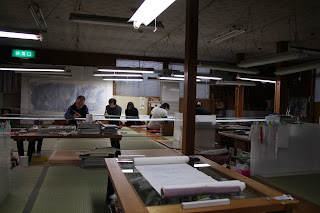This past 6 days, I had my latest artwork on show as part of a large group exhibition called the "International Exhibition of Art and Design". It was held in the Annex Building of the Kyoto Municipal Museum of Art. While the title (albeit vague) may perhaps conjure up images of grandeur and shiny display cases, don't let your imagination get carried away for the reality is that was a much more humble, honest display put on by a bunch of genuinely nice Artists from Japan and Abroad.
この6日間、新作が京都市美術館の別館で行われた「国際交流総合展」に展示していました。日本の作家と色んな国から来た作家による展覧会でした。
Group shows are by nature, a display by a
very diverse group of people. In this case, there were many different techniques, countries and ages represented. Textiles, Sculpture, Illustration, Painting, Ink-work; Australia, Great-Britain, the US, Finland, Japan, China, Venezuela...to name a few. You can see work from the artists
here. During the set-up we tried to make sure that works looked okay next to each other but whether you can make so many different artworks look good together, I'm not so sure. There were also some works where you go, "errr, okay..?" but the majority of works were really impressive and well-done.
グループ展というのは色んな人によるもので、今回も結構幅広いジャンルや国や年齢の方が参加しました。染織、立体、イラスト、絵、墨の作品などもありました。参加した作家さんはたくさんの国から来た人で、
ここで作品の例が見えます。
 |
| view of the exhibition. My work was next to a roketsu wax-resist work by Kobayashi Shoko. |
It's a group show like so many others in Kyoto; run by some kind of art organisation with submissions mostly from regular members but with fresh faces each year. However, unlike others, this group encourages foreigners to participate and seeks to encourage the exchange of ideas and cultures between Japanese and International artists.
京都ではこういう大型グループ展が毎週行われています。ほとんど同じ感じの展覧会(何かのアート団体が行うもので、毎年出品している人が居るけど、毎回初めて出品する人もいるっていうような展覧会)ですが、この展覧会は特に海外の作家を呼んで、国際交流も目指しているものです。
 |
| looking towards the back of the exhibition. On the middle panel at the back is my friend Kiyomi's wax-resist work. The motif and colours are similar to the one shown here |
 |
| gallery view |
This year was my first year to be involved and it was a great experience. It was a good opportunity to meet artists working in totally different techniques and to hear what they had to say about my work and to form some new connections with International and Japanese artists working in and around Kyoto. 今年初めて出品しました。全然違うジャンルで作業している作家と話ができて、京都と周りの地域で作業している人と出会えていい経験でした。
 |
| gallery view |
 |
| gallery view. |
Without further ado, let me show you the work that I exhibited! It's called "Going, going, gone" which is an explanation of the three parrot species depicted in the artwork; from right to left they are the Swift Parrot (Conservation Status is ENDANGERED), the Orange-bellied Parrot (Status: CRITICALLY ENDANGERED) and finally the Paradise Parrot (EXTINCT).
では!展示した新作を紹介します!「Going, going, gone」というタイトルの意味は、「無くなっている、無くなっている、無くなった」のです。右から左へ行くと、描写してある三種類のインコは、オトメインコ(絶滅危惧)、アカハラワカバインコ(絶滅寸前)とゴクラクインコ(絶滅)。つまり、このインコはgoing, going, goneですね。
 |
| "Going, Going, Gone" 2013. 180x200cm Silk, Yuzen Resist, Chemical Dyes |
 |
| Here's some of the Endangered Swift Parrots on the middle layer. You can see how it's partly see-through. 絶滅危惧種のオトメインコです。透明感のある生地を使いました。 |
 |
| These are Critically Endangered Orange-bellied Parrots. You can see the small sections of stylized text here which I`ll explain below. 絶滅寸前のアカハラワカバインコです。背景に文章が見えますね。下に説明します。 |
 |
Here's a female and male Paradise Parrot, thought to have become extinct around the 1930's.
1930年代ぐらいに絶滅したゴクラクインコです。 |
In this piece, I used three different layers of silk fabric, beginning with a heavy silk at the back, then a lighter georgette silk, and finally a very transparent organza at the front. I wanted to create depth as well as give the impression of the birds coming in and out of focus; appearing and disappearing. Also, the flight from right to left is taken from the tendency to show the flow of time in Japanese paintings as running from right to left.
今回初めて透明感のある絹を使ってみました。作品は3レヤーになっています。後ろにはしっかりしているちりめんと紬で、間中に半分透明のジョージェットを使って、一番前に薄くて透明なオルガンジを使いました。透明生地を使うのは、奥行きを表現したかったし、鳥が出たり隠されたりするのを見せたかったです。
 |
| "Going, going, gone" (detail) Here you can see from right to left, Swift, Orange-bellied and Paradise Parrots. 右から:オトメインコ、アカハラワカバインコ、ゴクラクインコ。 |
You may be able to see the texture in the work behind the birds? This is fragments of text from writings by ornithologist John Gould (1804-1881). He was an Englishman but spent several years in Australia (mostly in Tasmania) observing and writing about Australian birds. His writings are very descriptive and I love the flowery language he used. The tragic thing is when Gould wrote about these they were still common (well, the Paradise Parrot was already on his way out) but now they are in serious danger of disappearing.
鳥の裏に文章が見えるでしょうか?それは19世紀の鳥類学者ジョン・グルドがこの三種類のインコについて書いた文章から取った部分です。彼の英語がとても華やかで面白いです。悲しいのグルドが書いたときにオトメインコとアカハラワカバインコはまだ多かったけど今はもう消える可能性があります。
I was really glad to see that my work was moving slightly in the gallery space, as people walked by or just in the air-conditioning. ギャラリーで作品が下のようにちょっと動いていてとてもよかったです。鳥が本当に飛んでいるのを感じさせます!
my work moving in the breeze
And so it's onward to the next exhibition!! Coming up so soon it's frightening is this group exhibition I am a part of with the 5 other Textiles Master's course students, "How How". It runs November 12-19 in Kyoto and more information can be found
here. On that note, time to go get back to work!!
次の展覧会ももうすぐです!京都精華の大学院染織コースの6人による「HowHow」というグループ展です!京都にいらっしゃる方、ぜひみに来てください!
では、制作しなきゃ~!


















































